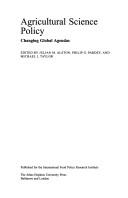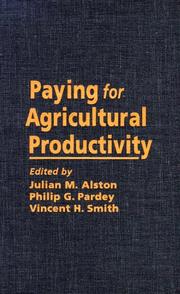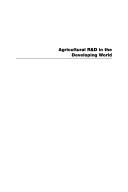
ISBN: 0801866049 0801866030 Year: 2001 Publisher: Baltimore Johns Hopkins university press
Abstract | Keywords | Export | Availability | Bookmark
 Loading...
Loading...Choose an application
- Reference Manager
- EndNote
- RefWorks (Direct export to RefWorks)
63.001.5 --- 001.89 --- 338.43.01 --- Agricultural research --- Organisatie van wetenschap en wetenschappelijk werk. Wetenschapsbeleid --- Landbouwbeleid --- Agriculture and state. --- Social Sciences and Humanities. Agricultural Economics --- Agricultural Policy --- Agricultural Policy. --- 001.89 Organisatie van wetenschap en wetenschappelijk werk. Wetenschapsbeleid --- 63.001.5 Agricultural research --- Agriculture and state --- Agrarian question --- Agricultural policy --- Agriculture --- State and agriculture --- Economic policy --- Land reform --- Government policy

ISBN: 0801861853 0801862787 Year: 1999 Publisher: Baltimore Johns Hopkins university press
Abstract | Keywords | Export | Availability | Bookmark
 Loading...
Loading...Choose an application
- Reference Manager
- EndNote
- RefWorks (Direct export to RefWorks)
Agriculture --- Basic Sciences. Agriculture --- Research --- Finance --- Case studies. --- Agriculture (General) --- 63.001.5 --- Agricultural research --- Agriculture (General). --- 63.001.5 Agricultural research --- Farming --- Husbandry --- Industrial arts --- Life sciences --- Food supply --- Land use, Rural --- Research&delete& --- Finance&delete& --- Case studies
Digital
ISBN: 9780387369532 Year: 2006 Publisher: Boston, MA Springer Science+Business Media, LLC
Abstract | Keywords | Export | Availability | Bookmark
 Loading...
Loading...Choose an application
- Reference Manager
- EndNote
- RefWorks (Direct export to RefWorks)

ISBN: 089629756X Year: 2006 Publisher: Washington (D.C.) International food policy research institute
Abstract | Keywords | Export | Availability | Bookmark
 Loading...
Loading...Choose an application
- Reference Manager
- EndNote
- RefWorks (Direct export to RefWorks)
Agricultural innovations --- Agriculture --- Economic aspects --- Research
Book
Year: 2002 Publisher: Washington (D.C.): International food policy research institute
Abstract | Keywords | Export | Availability | Bookmark
 Loading...
Loading...Choose an application
- Reference Manager
- EndNote
- RefWorks (Direct export to RefWorks)
Book
Year: 2012 Publisher: [Washington, D.C.] : U.S. Dept. of Agriculture, Economic Research Service,
Abstract | Keywords | Export | Availability | Bookmark
 Loading...
Loading...Choose an application
- Reference Manager
- EndNote
- RefWorks (Direct export to RefWorks)
Food preferences --- Food --- Grocery shopping --- Food consumption forecasting --- Consumers' preferences --- Consumption (Economics) --- Elasticity (Economics) --- Demand (Economic theory) --- Home economics --- Costs --- Econometric models. --- Accounting.
Book
ISBN: 9780387369532 Year: 2006 Publisher: Boston MA Springer US
Abstract | Keywords | Export | Availability | Bookmark
 Loading...
Loading...Choose an application
- Reference Manager
- EndNote
- RefWorks (Direct export to RefWorks)
This book presents the first thorough economic analysis of current agricultural biotechnology regulation. The contributors, most of whom are agricultural economists working either in universities or NGOs, address issues such as commercial pesticides, the costs of approving new products, liability, benefits, consumer acceptance, regulation and its impacts, transgenic crops, social welfare implications, and biosafety. Richard E. Just is Distinguished University Professor and former Chair, Department of Agricultural and Resource Economics, University of Maryland at College Park. Julian M. Alston is Professor, Department of Agricultural and Resource Economics, University of California at Davis. David Zilberman is Chair, Department of Agricultural and Resource Economics, University of California at Berkeley.
Book
ISBN: 0801429374 9780801429378 Year: 1995 Publisher: Ithaca: Cornell university press,
Abstract | Keywords | Export | Availability | Bookmark
 Loading...
Loading...Choose an application
- Reference Manager
- EndNote
- RefWorks (Direct export to RefWorks)
Digital
ISBN: 9781441906588 9781441906595 9781461425236 9781441906571 Year: 2010 Publisher: New York, NY Springer
Abstract | Keywords | Export | Availability | Bookmark
 Loading...
Loading...Choose an application
- Reference Manager
- EndNote
- RefWorks (Direct export to RefWorks)
This book documents the evolving path of U.S. agriculture in the 20th Century and the role of public R&D in that evolution. The work begins with a detailed quantitative assessment of the shifting patterns of production among the states and over time and of the public institutions and investments in agricultural R&D. Then, based on newly constructed sets of panel data, some of which span the entire 20th Century and more, the authors present new econometric evidence linking state-specific agricultural productivity measures to federal and state government investments in agricultural research and extension. The results show that the time lags between R&D spending and its effects on productivity are longer than commonly found or assumed in the prior published work. Also, the spillover effects of R&D among states are important, such that the national net benefits from a state’s agricultural research investments are much greater than own-state net benefits. The main findings are consistent across a wide range of reasonable model specifications. In sum, the benefits from past public investments in agricultural research have been worth many times more than the costs, a significant share of the benefits accrue as spillovers, and the research lags are very long. An accelerated investment in public agricultural R&D is warranted by the high returns to the nation, and may be necessary to revitalize U.S. agricultural productivity growth even though the benefits may not be visible for many years. Julian M. Alston is Professor in the Department of Agricultural and Resource Economics and Director of the Robert Mondavi Institute Center for Wine Economics at the University of California, Davis and Associate Director for Science and Technology at the University of California Agricultural Issues Center Matthew A. Andersen is Assistant Professor in the Department of Agricultural and Applied Economics at the University of Wyoming Jennifer S. James is Associate Professor in the Department of Agribusiness at California Polytechnic State University, San Luis Obispo Philip G. Pardey is Professor in the Department of Applied Economics and Director of the International Science and Technology Practice and Policy (InSTePP) Center at the University of Minnesota.
Economic policy and planning (general) --- Agronomy --- technologiebeleid --- economische politiek --- landbouwbeleid --- United States of America
Book
Year: 2020 Publisher: Cambridge, Mass. National Bureau of Economic Research
Abstract | Keywords | Export | Availability | Bookmark
 Loading...
Loading...Choose an application
- Reference Manager
- EndNote
- RefWorks (Direct export to RefWorks)
U.S. agriculture was transformed during the 20th century by waves of innovation with mechanical, biological, chemical, and information technologies. Compared with a few decades ago, today's agriculture is much less labor intensive and farms are much larger and more specialized, supplying a much-evolved market for farm products. Over recent decades, the global landscape for agricultural R&D has shifted away from farms, away from the public sector toward the private sector, and away from the United States towards agriculturally important middle-income countries, especially China, India and Brazil. U.S. investments in agricultural R&D are stalling even though meta-evidence shows that past U.S. investments in agricultural R&D have yielded very favorable returns: median reported benefit-cost ratios in the range of 12:1. Sustained U.S. investment and innovation will be required to preserve past productivity gains in the face of climate change, coevolving pests and diseases, and changing technological regulations--let alone increase productivity. Great potential exists for innovation in crop and livestock genetics and digital farming technologies to generate new products and production processes, but innovators are facing increasingly strong headwinds from social and political forces that seek to dictate technology choices.

 Search
Search Feedback
Feedback About UniCat
About UniCat  Help
Help News
News